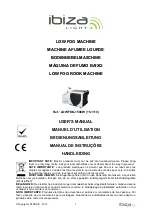
Skipped Stitches
If your machine is skipping stitches, straight stitches will have stitch lengths that look
exceptionally long at times.
A skipped stitch means the gib hook is not catching the thread consistently. There are
a number of causes for skipped stitches.
Start with Step 1 and stop as soon as the problem is resolved.
1. Incorrectly Installed, Bent, or Dirty Needle
A bent needle will cause skipped stitches because the loop is not where the gib hook (p. 71,
16
) “expects” it to be. Adhesive residue on the needle will cause the thread to stick to the
needle instead of moving through the eye to form a loop.
Make sure your needle is installed correctly (p. 26), is not bent or damaged, and is free of any
residue from sewing adhesive material. Fouled needles may be cleaned with rubbing alcohol.
Bent or damaged needles must be replaced.
2. Turning Corners Correctly
You can turn gentle corners while sewing at slow, consistent speeds. If motion is stopped
and a change of direction is desired, set the needle position and raise the presser foot prior
to the turn.
Bury the needle going to the bottom position of the needle bar stroke and continue until the
needle comes up 1/8 inch.
Stop and lift the foot to twist the sewn assembly and make a direction change. Drop the
presser feet and continue sewing. Follow these directions to avoid badly tensioned corner
stitches and reduce the chance of a skipped stitch.
3. Not Enough Foot Pressure
Materials like dense, vegetable tanned leather, can make the withdrawal of the needle from
the material difficult.
If the presser foot is being lifted as the needle comes out of the leather the loop that the
needle forms will be too small.
Increase the downward pressure on the presser foot by tightening the pressure regulating
thumb screw (p. 38,
58
).
4. Burred Gib Hook or Retaining Ring Cap Spring (
68
)
A needle strike to the gib hook (
A
) or the edge of the retaining ring cap spring’s “triangular”
opening (
B
) may result in a burr which can cause the thread to snag as it pulls through.
Remove any burrs by polishing them with emery paper or a fine file. If badly damaged,
replace with a new retaining ring cap spring (#1603). One spare cap spring is included.
5. Machine Has Gone Out of Timing
If skipped stitches continue, the machine has probably gone out of timing. The timing is checked
by determining the relationship of the needle to the gib hook point.
To reset the timing on your Stitch Master, follow the steps outlined on p. 58 “Stitch Master Timing”.
Burred Area
Burred Area
>
Retaining Ring Cap Spring
>
Gib Hook
A
B
68
Stitch Master
®
Guidebook: Troubleshooting
50
49
















































